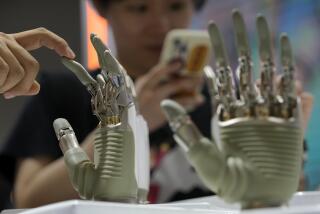PERSPECTIVE ON EMPLOYMENT : Meet the Nimble New Middle Class : Lifetime factory jobs may be dead, but the people who can keep technology humming are in the catbird seat.
A generation ago, most Americans could expect to find decent work right out of high school, and many could hold the same job until retirement. It helped to be white and male, of course, but the economic boom after World War II created millions of good jobs. And these jobs, in turn, created a huge market for the products made by the people in the good jobs. Mass production spawned the great American middle class; the middle class fueled mass production.
That old economy is disappearing and, as usual, Californians face the future first. The recession, corporate downsizing (like Pacific Telesisâ recent decision to cut 10,000 jobs) and shrinking defense budgets have dominated the economic news, but they mask a deeper trend. High volume is giving way to high value.
Low production costs no longer depend on large scale. Through computer-aided design, engineering and fabrication, products can be tailored to the wants of small groups of customers without much additional cost. Automobiles, magazines, even computer chips can be made to order. The real value comes in discovering who wants what and getting it to them quickly. Good jobs go to people who continuously identify unmet needs and then figure out profitable ways to meet them.
And as mass production disappears, the old middle class is following in its path. High-paying, low-skilled jobs are vanishing. Well-educated people are doing reasonably well. (Yes, itâs true that platoons of engineers, scientist, advertising executives and management consultants are still out of work. But as the economy recovers from its recessionary blues, most of them will get back on their feet.) It is the less educated--those with only a high-school diploma or less--who are suffering most. Their real wages have been sinking for years, with no end in sight. High school graduates are three times more likely to be unemployed than people with college degrees.
So whatâs the answer? We canât turn back the clock to the safe old world of mass production. Nor should we. Technology offers too many benefits. Nor can we guarantee that every American gets a college degree. Thatâs unrealistic, even unnecessary.
The real answer, and the cause for optimism, lies in a trend just emerging from the occupational statistics. Look closely and youâll find a growing demand for technicians--people with the skills to test, repair, upgrade and sell complex products. The Bureau of Labor Statistics predicts that jobs for technicians will increase 37% from 1990 to 2005.
Technician jobs often defy the established categories of the old economy, where âwhite-collarâ managers oversaw the efforts of âblue-collarâ line workers. The distinctions between blue collar and white collar are blurring, and out of this blur is emerging an entirely new group. These workers often wear ties or dresses (as did their white-collar predecessors). But they also often work with their hands, use tools and monitor machinery (as did their blue-collar predecessors).
They sit behind computers in factories, laboratories and office towers, monitoring complex equipment. They integrate and test computer systems. They create customized office-phone networks. They fix or replace electronic devices in automobiles. They do legal research. They repair copy machines. They run hospital tests.
Technician jobs usually require some education beyond high school (although not necessarily at a four-year college). And technicians, like all American workers, will need to upgrade their skills as technology and competition regularly reshape markets. Unlike the old world of mass production, with its relatively secure jobs, the new economy will require frequent, sometimes painful, transitions--from old jobs to new jobs, from obsolete occupations to cutting-edge trades. Security will be found not by burrowing into a single job, but through the flexibility that comes with up-to-date skills.
The old educational system, geared to a mass-production economy, sent forth large numbers of young people ready to follow directions and perform routine and highly structured tasks. When the economy cycled downward and they were laid off, unemployment insurance tided them over until they got their jobs back. Today, when most workers who lose their jobs lose them forever, the old structures must give way to a new system of lifelong learning. That is why this month President Clinton announced plans to transform the unemployment system into a re-employment system that launches workers into new jobs. And itâs why measures like establishing tough standards for American schools and developing an effective school-to-work transition system form the core of the Administrationâs economic agenda.
Today more than ever (and in California more than most places), new questions are testing both our policies and our imaginations. What happened to the middle class? Itâs re-emerging in our midst--a new work force mainstay of problem-solving technicians, armed with the flexible skills to prosper in the next century. The middle class is dead; long live the middle class.
More to Read
Inside the business of entertainment
The Wide Shot brings you news, analysis and insights on everything from streaming wars to production â and what it all means for the future.
You may occasionally receive promotional content from the Los Angeles Times.










